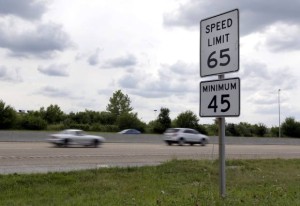
Crawling along I-95 the other day in the usual bumper-to-bumper traffic, I snickered when I noticed the “Speed Limit 55” sign alongside the highway. I wish …
Of course, when the highway is not jammed, speeds are more like 70 mph with the legal limit, unfortunately, rarely being enforced. Which got me thinking: who sets speed limits on our highways and by what criteria?
Why is the speed limit on I-95 in Fairfield County only 55 mph but 65 mph east of New Haven? And why is the speed limit on I-84 just 55 mph from the New York border to Hartford, but 65 mph farther east in “the Quiet Corner”? Why does the eastern half of the state get a break?
Blame the Office of the State Traffic Administration (OSTA) in the CDOT. This body regulates everything from speed limits to traffic signals, working with local traffic authorities (usually local Police Departments, mayors or Boards of Selectmen).
OSTA is also responsible for traffic rules for trucks (usually lower speed limits) including the ban on their use of the left hand lane on I-95 in most places.
It was the Federal government (Congress) that dropped the Interstate speed limit to 55 mph in 1973 during the oil crisis, only to raise it to 65 mph in 1987 and repeal the ban altogether in 1995 (followed by a 21% increase in fatal crashes), leaving it to each state to decide what’s best.
In Arizona and Texas that means 75 mph while in Utah some roads support 80 mph. Trust me … having recently driven 1000+ miles in remote stretches of Utah, things happen very fast when you’re doing 80 – 85 mph!
About half of Germany’s famed Autobahns have speed limits of 100 km/hr (62 mph), but outside of the cities the top speed is discretionary. A minimum of 130 km/hr (81 mph) is generally the rule, but top speed can often be 200 km/hr (120 mph).
Mind you, the Autobahn is a superbly maintained road system without the bone-rattling potholes and divots we enjoy on our highways. And the German-built Mercedes and Audis on these roads are certainly engineered for such speed.
American cars are designed for maximum fuel efficiency in the 55 – 60 mph range. Speed up to 65 mph and your engine runs 8 percent less efficiently. At 70 mph, the loss is 17 percent. That adds up to more money spent on gasoline and more environmental pollution, all to save a few minutes of driving time.
But even bigger than the loss of fuel efficiency is aerodynamic drag, which can eat up to 40 percent of total fuel consumption. Lugging bulky roof-top cargo boxes worsens fuel economy by 25 percent at interstate speeds. So does carrying junk in your trunk (or passengers!): a 1 percent penalty for every 100 pounds.
Even with cheaper gasoline, it all adds up!

Editor’s Note: Jim Cameron is founder of The Commuter Action Group, and a member of the Darien RTM. The opinions expressed in this column are only his own.
You can reach him at CommuterActionGroup@gmail.com
For a full collection of “Talking Transportation” columns, see www.talkingtransportation.blogspot.com